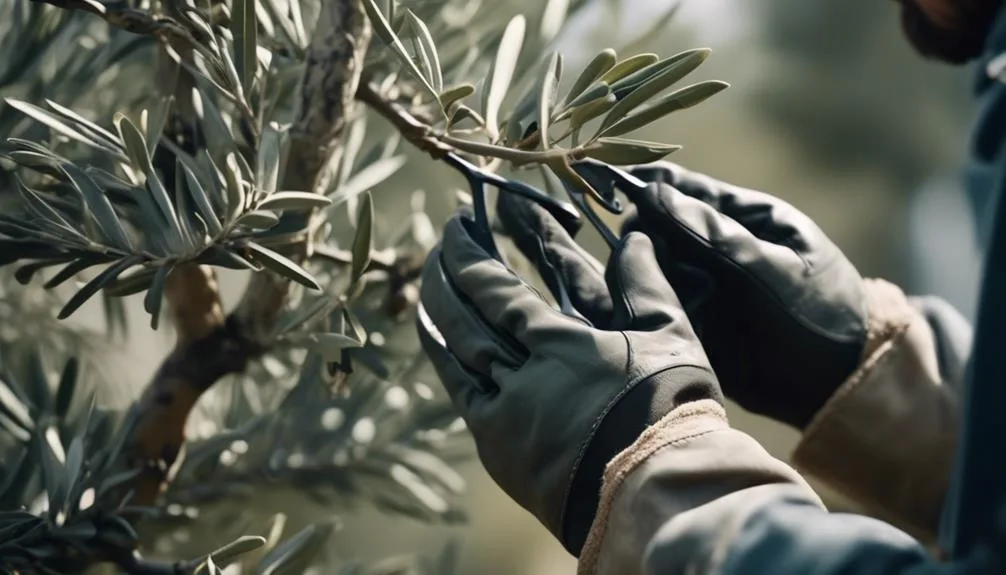Pruning olive trees is crucial for their health and productivity. Understanding the right tools and growth patterns is key. In this discussion, we'll explore the best pruning techniques for optimal growth and a bountiful harvest.
Whether you're new to olive tree care or a seasoned enthusiast, mastering pruning is essential. Let's uncover the secrets to effective olive tree pruning for success.
Key Takeaways
- Select and use the right tools for pruning olive trees, such as pruning shears, loppers, long-handled pruning saws, and pole pruners.
- Understand olive tree growth patterns and focus on removing dead, diseased, crossing, and rubbing branches to promote open canopy and encourage desired upward and outward growth.
- Prune olive trees in late spring or early summer, shortly after flowering, with regular, light pruning every 1-2 years for healthier and more fruitful trees.
- Use precise cuts, promote better air circulation and sunlight penetration, avoid over-pruning and improper cuts, and prioritize removing dead or diseased branches first while shaping the tree.
Selecting the Right Tools
When selecting the right tools for pruning olive trees, it's essential to ensure that they're sharp, appropriate for the task, and comfortable to use. Selecting appropriate tools is crucial for maintaining equipment effectiveness.
Pruning shears are vital for precision cuts on small branches, while loppers are ideal for thicker branches. Ensure that the cutting blades are sharp to make clean cuts and minimize damage to the tree.
Long-handled pruning saws are essential for reaching higher branches and for thicker branches that are too large for loppers. Additionally, pole pruners are useful for reaching even higher branches without the need for a ladder.
Invest in high-quality tools with ergonomic handles to minimize hand fatigue and ensure comfort during prolonged use. Proper tool selection is the first step to successful olive tree pruning.
Understanding Olive Tree Growth Patterns
Selecting the right tools for pruning olive trees is crucial, and understanding the growth patterns of olive trees is equally important for successful pruning. Olive trees have a natural growth habit characterized by outward and upward growth. Understanding these growth patterns is essential for making precise cuts that promote healthy growth.
When pruning, it's important to focus on removing dead or diseased branches, as well as those that are crossing or rubbing against each other, to allow for better air circulation and sunlight penetration. By understanding pruning methods that encourage outward growth, you can help the tree maintain an open canopy, which is essential for fruit production and overall tree health.
Additionally, promoting upward growth by selectively pruning can help maintain the tree's desired size and shape.
Timing and Frequency of Pruning
To effectively prune olive trees, it's important to understand the timing and frequency of pruning to ensure optimal growth and fruit production. The timing of pruning is crucial for the overall health and productivity of olive trees.
Here are some essential points to consider:
- Pruning Season: Prune olive trees during late spring or early summer to avoid interfering with the tree's natural growth cycle and to minimize the risk of frost damage.
- Optimal Timing: Aim to prune shortly after the olive tree has finished flowering to promote new growth and fruit production.
- Pruning Intervals: Regular, light pruning every 1-2 years is preferable to heavy pruning less frequently, as it can have long-term negative effects on the tree's health and productivity.
- Long Term Effects: Proper pruning at the right intervals can lead to healthier, more fruitful olive trees in the long run.
Techniques for Pruning Olive Trees
Prune olive trees using precise cuts to encourage new growth and enhance fruit production, ultimately promoting the overall health of the tree.
Pruning benefits the tree by allowing better air circulation and sunlight penetration, reducing the risk of diseases, and promoting a stronger structure.
When pruning, it's important to avoid common mistakes such as over-pruning, which can lead to excessive vegetative growth at the expense of fruit production, and improper cuts that can leave the tree vulnerable to pests and diseases.
To ensure successful pruning, start by removing dead or diseased branches, then focus on shaping the tree to allow sunlight to reach all parts of the canopy.
Always use sharp, clean tools and make cuts at a slight angle just above a bud or lateral branch to encourage healthy regrowth.
Addressing Common Pruning Challenges
If you've encountered challenges while pruning your olive trees, mastering effective solutions can significantly improve the health and productivity of your trees. Addressing common pruning challenges is crucial for maintaining the well-being of your olive trees.
Here are some tips to overcome these obstacles:
- Branch Weight: Trim heavy branches to maintain a balanced tree structure and prevent them from breaking under their own weight.
- Disease Prevention: Regularly sanitize your pruning tools to prevent the spread of diseases between trees.
- Over-Pruning: Avoid excessive pruning, as it can stress the tree and reduce fruit production.
- Proper Timing: Prune during the tree's dormant period to minimize stress and maximize recovery.
Conclusion
Incorporating the best pruning techniques for olive trees will help you maintain their health and productivity with confidence. By using the right tools, understanding growth patterns, and timing your pruning correctly, you can ensure thriving olive trees.
Addressing common challenges like over-pruning or neglect is essential, so always aim for a balanced and well-maintained tree.
Happy pruning and may your olive trees flourish for years to come!

